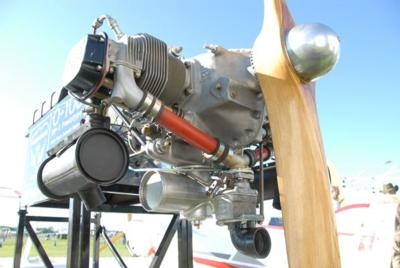Engine Will Be Targeted At The Single And Light 2-Place LSA Market
By Anthony Liberatore
Over the last 3 years Pete Plumb of Pegasus Power has been working diligently to bring his 0-100 kit engine from an idea of a more powerful engine for his "Cracker Jack" parasol which he designed himself, to a deliverable item to customers. The O-100 that Pete is developing is a 2 cylinder horizontally-opposed 4 stroke engine which is a hat tip to the tried and proven O-200's many of us learned to fly behind. Coming in at 57 hp, the O-100 might be too big for a true ultralight, but fills a void for those wanting an engine in this horsepower class for their single (and light 2 seat) LSA type aircraft they are building, and for a host of reasons prefer not to go the 2 stroke route or want to replace their existing 2 stroke with a 4 stroke.

This 2 cylinder boxer has a unique design feature that is a potentially a first in the aviation area and that is the material and process that the crankshaft is made of. The material is ADI, Austetic Ductile Iron. ADI is a specific Iron alloy and has been utilized for crankshaft applications in the automotive, diesel, and small engine arenas. While the crankshaft is made via the casting process, ADI's material properties approach those of the some of high end alloys we often associate with crankshafts. The casting process also has a number of advantages such as allowing Pete to easily incorporate counterweights and Charles Taylor formula derived connection rod journal lightening holes. Pete's calculations on maximum rotational and bending loads on the Pegasus's crankshaft will be at 22% of it's design ultimate, and that The S-N curves on ADI show anything less than 33% of ultimate never break.
I spoke to Pete earlier this week, he was gearing up to drive to Oshkosh from his California base with his DP-1 Prototype on it's trailerable test rig. It was a last minute decision for Pete to attend, however much has gone on to update the aviation community on in regards to his programs progress and this news will be an Aero-News exclusive. In my discussion with Pete he noted that with the engine being designed via a Solid Works CAD system the CAD files have allowed all the parts of the kit that are casted from the vacuum cast process (that the suppliers are utilizing) are quite visually appealing. If you have been following the O-100's progress, you'll notice the website hasn't been updated in a while, as Pete has been very busy attending to the logistics of manufacturing side.
This focus on the manufacturing side is time intensive and where the rubber meets the road to make this engine an actual deliverable product to customers in the near future. Behind the scenes, Pete has been securing casting, machining, and heat treating vendors to produce the various components that will go into the O-100's Kit. What parts Pete will not supply to the kit, the builders will, which makes this engine unique. The builder will supply cylinders, valve train components and other existing engine parts such as intake tubes that could potentially take from an existing O-200 they may own, or purchase them new from the various engine suppliers such as ECi. Pete tells me that while at Oshkosh he intends run the engine for attendees and elaborated more on the this engine's status and that of the future test engines.
Pete noted with all the focus on manufacturing run time on Engine No. 1 is low as this part of the program took a back seat, and during the initial testing phase, a piston and ring design issues surfaced that was not satisfactory to Pete and design changes were made that will be incorporated in the production versions. With the bulk of the production logistics ironed out, Pete said his next focus will be to build 10 Beta Engines from the suppliers 1st run of parts that denote production intent. The 1st Beta engine will be the non-flight test endurance mule. Pete wants to run Beta 1 very hard on the Test Rig and noted he would like to run the FAR 33 150hr endurance test on this engine as well. Pete noted Beta 2 will be for display, and Beta 3 will be the flight test engine with his son doing the flying behind it. For his son's safety and for the customers as well, he intends to be a stickler about the 0-100's durability.
While durability is a focus, so is price point. Pete has told Aero-News that he intends to market the 1st 100 engines that include the lightweight connection rods and lightweight forged 9:1 compression ratio pistons that help insure a dynamically balanced rotating assembly ( vs. Using the stock pistons ) for $3,495.
(Staff image)
 Airbus Racer Helicopter Demonstrator First Flight Part of Clean Sky 2 Initiative
Airbus Racer Helicopter Demonstrator First Flight Part of Clean Sky 2 Initiative Diamond's Electric DA40 Finds Fans at Dübendorf
Diamond's Electric DA40 Finds Fans at Dübendorf ANN's Daily Aero-Term (04.23.24): Line Up And Wait (LUAW)
ANN's Daily Aero-Term (04.23.24): Line Up And Wait (LUAW) NTSB Final Report: Extra Flugzeugbau GMBH EA300/L
NTSB Final Report: Extra Flugzeugbau GMBH EA300/L Classic Aero-TV: 'Never Give Up' - Advice From Two of FedEx's Female Captains
Classic Aero-TV: 'Never Give Up' - Advice From Two of FedEx's Female Captains



